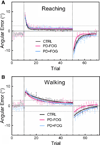Prism adaptation in Parkinson disease: comparing reaching to walking and freezers to non-freezers
- PMID: 25976516
- PMCID: PMC4513667
- DOI: 10.1007/s00221-015-4299-4
Prism adaptation in Parkinson disease: comparing reaching to walking and freezers to non-freezers
Abstract
Visuomotor adaptation to gaze-shifting prism glasses requires recalibration of the relationship between sensory input and motor output. Healthy individuals flexibly adapt movement patterns to many external perturbations; however, individuals with cerebellar damage do not adapt movements to the same extent. People with Parkinson disease (PD) adapt normally, but exhibit reduced after-effects, which are negative movement errors following the removal of the prism glasses and are indicative of true spatial realignment. Walking is particularly affected in PD, and many individuals experience freezing of gait (FOG), an episodic interruption in walking, that is thought to have a distinct pathophysiology. Here, we examined how individuals with PD with (PD + FOG) and without (PD - FOG) FOG, along with healthy older adults, adapted both reaching and walking patterns to prism glasses. Participants completed a visually guided reaching and walking task with and without rightward-shifting prism glasses. All groups adapted at similar rates during reaching and during walking. However, overall walking adaptation rates were slower compared to reaching rates. The PD - FOG group showed smaller after-effects, particularly during walking, compared to PD + FOG, independent of adaptation magnitude. While FOG did not appear to affect characteristics of prism adaptation, these results support the idea that the distinct neural processes governing visuomotor adaptation and storage are differentially affected by basal ganglia dysfunction in PD.
Conflict of interest statement
Figures



Similar articles
-
Reduced after-effects following podokinetic adaptation in people with Parkinson's disease and freezing of gait.Parkinsonism Relat Disord. 2016 Jan;22:93-7. doi: 10.1016/j.parkreldis.2015.11.024. Epub 2015 Nov 26. Parkinsonism Relat Disord. 2016. PMID: 26639981 Free PMC article.
-
How do age and nature of the motor task influence visuomotor adaptation?Gait Posture. 2015 Oct;42(4):564-8. doi: 10.1016/j.gaitpost.2015.09.001. Epub 2015 Sep 8. Gait Posture. 2015. PMID: 26385199 Free PMC article.
-
Subthalamic neural entropy is a feature of freezing of gait in freely moving people with Parkinson's disease.Neurobiol Dis. 2017 Dec;108:288-297. doi: 10.1016/j.nbd.2017.09.002. Epub 2017 Sep 7. Neurobiol Dis. 2017. PMID: 28890315 Free PMC article.
-
[Gait disturbances related to dysfunction of the cerebral cortex and basal ganglia].Brain Nerve. 2010 Nov;62(11):1193-202. Brain Nerve. 2010. PMID: 21068456 Review. Japanese.
-
Freezing beyond gait in Parkinson's disease: a review of current neurobehavioral evidence.Neurosci Biobehav Rev. 2014 Jun;43:213-27. doi: 10.1016/j.neubiorev.2014.04.010. Epub 2014 Apr 23. Neurosci Biobehav Rev. 2014. PMID: 24769288 Review.
Cited by
-
Inclination of standing posture due to the presentation of tilted view through an immersive head-mounted display.J Phys Ther Sci. 2017 Feb;29(2):228-231. doi: 10.1589/jpts.29.228. Epub 2017 Feb 24. J Phys Ther Sci. 2017. PMID: 28265145 Free PMC article.
-
Quantifying motor adaptation in a sport-specific table tennis setting.Sci Rep. 2024 Jan 5;14(1):601. doi: 10.1038/s41598-023-50927-2. Sci Rep. 2024. PMID: 38182640 Free PMC article.
-
Cerebellar Volume and Executive Function in Parkinson Disease with and without Freezing of Gait.J Parkinsons Dis. 2017;7(1):149-157. doi: 10.3233/JPD-161029. J Parkinsons Dis. 2017. PMID: 28106569 Free PMC article.
-
Multi-Trial Gait Adaptation of Healthy Individuals during Visual Kinematic Perturbations.Front Hum Neurosci. 2017 Jun 20;11:320. doi: 10.3389/fnhum.2017.00320. eCollection 2017. Front Hum Neurosci. 2017. PMID: 28676750 Free PMC article.
References
-
- Baizer JS, Kralj-Hans I, Glickstein M. Cerebellar lesions and prism adaptation in macaque monkeys. J Neurophysiol. 1999;81:1960–1965. - PubMed
-
- Bloem BR, Hausdorff JM, Visser JE, Giladi N. Falls and freezing of gait in Parkinson’s disease: a review of two interconnected, episodic phenomena. Mov Disord. 2004;19:871–884. - PubMed
Publication types
MeSH terms
Grants and funding
LinkOut - more resources
Full Text Sources
Other Literature Sources
Medical

